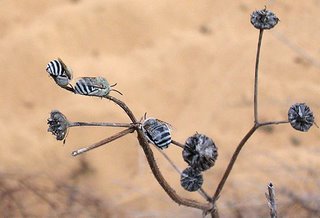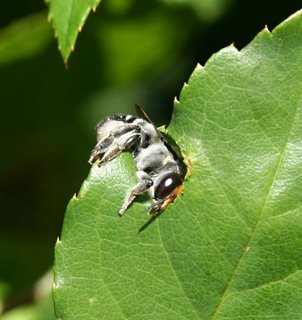Most bees and wasps are tiny, exquisite insects. They go about their business unnoticed. But a few are big, bright and bold enough to make a splash.
 Blue-banded bees (Amegilla cingulata) are widespread across southern Australia. These males, photographed at Margaret River in WA, are snoozing on a thistle. Each has clamped his jaws onto a stem to hold himself in place. Although normally solitary, these fellows have gathered together over a pile of sand, where several females have dug burrows. They'll be the first on site when the females emerge in the morning.
Blue-banded bees (Amegilla cingulata) are widespread across southern Australia. These males, photographed at Margaret River in WA, are snoozing on a thistle. Each has clamped his jaws onto a stem to hold himself in place. Although normally solitary, these fellows have gathered together over a pile of sand, where several females have dug burrows. They'll be the first on site when the females emerge in the morning. Beautiful as they are, blue-banded bees can cause problems by excavating burrows in mud bricks and mortar. Leafcutter bees (Megachile) aren't quite as destructive but will use holes and cracks in buildings to construct their small, leaf-lined nests.
Beautiful as they are, blue-banded bees can cause problems by excavating burrows in mud bricks and mortar. Leafcutter bees (Megachile) aren't quite as destructive but will use holes and cracks in buildings to construct their small, leaf-lined nests.  Females snip out pieces from leaves, which they then carry back to the home site and glue together. (The Airfix school of construction.) They prefer soft vegetation (they're not daft), so they tend to favour garden plants over more robust natives.
Females snip out pieces from leaves, which they then carry back to the home site and glue together. (The Airfix school of construction.) They prefer soft vegetation (they're not daft), so they tend to favour garden plants over more robust natives.[Many thanks to MM for providing these stunning pictures of native bees.]